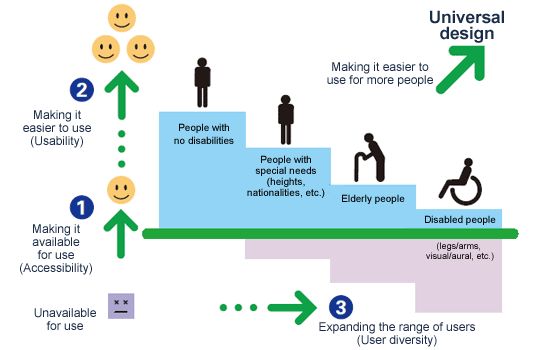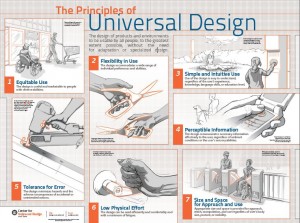“Universal Design is the design and composition of an environment so that it can be accessed, understood and used to the greatest extent possible by all people regardless of their age, size, ability or disability” (Centre for Excellence in Universal Design). However, as Brian Kelly commented, when discussing this subject in a blog entitled ‘Web Accessibility – Code of Practice (BS 8878:2010)’
“the Code of Practice correctly acknowledges the complexities in seeking to enhance accessibility of Web products for people with disabilities. It was also good to see the references to ‘inclusive design’ rather than the ‘universal design’ which, I feel, leads people to believe that a single universal solution is possible or, indeed desirable.”
The toolkit developed by the University of Cambridge, Engineering Design Centre and sponsored by BT asks:
and then offers Inclusive design tools and discusses User capabilities
Benefits of Inclusive / Universal Design
There are numerous benefits to be gained from making innovative designs have universal appeal and be as inclusive as possible. The Centre for Excellence in Universal Design divides them up into the following categories:
- Benefits to the individual – user-friendly and convenient, but is also respectful of user dignity, rights and privacy.
- Benefits to society – increased life expectancy and medical developments – more technology based assistance needed with demographic changes.
- Business benefits – increases in potential markets to increased customer satisfaction.
- Legislation and standards -promotes compliance, but has much wider potential for improving accessibility and usability, beyond the minimum requirements enforced by law.
7 Principles of Universal Design
These are taken from NC State University Center for Universal Design(text version of the downloadable poster below)
Principle 1: Equitable Use
Principle 2: Flexibility in Use
Principle 3: Simple and Intuitive Use
Principle 4: Perceptible Information
Principle 5: Tolerance for Error
Principle 6: Low Physical Effort
Principle 7: Size and Space for Approach and Use


